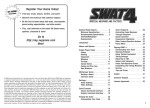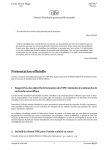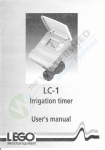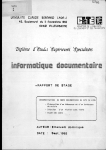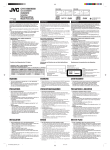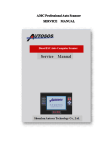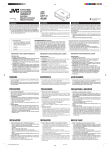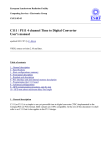Download 2038 IEEE Transactions on Nuclear Science, Vol. NS
Transcript
© 1985 IEEE. Personal use of this material is permitted. However, permission to reprint/republish this material for advertising or promotional purposes or for creating new collective works for resale or redistribution to servers or lists, or to reuse any copyrighted component of this work in other works must be obtained from the IEEE. 2038 IEEE Transactionson NuclearScience,Vol. NS-32,No. 5, October1985 MACINTROTTE F. D1 Maio and F. Perrlollat CERN, 1211 Geneva 23, Switzerland Introduction FquiPment Testins, In hierarchically structured control systems’,* like the one at the PS accelerator complex, it is crucial to dispose of means for local interaction at several levels, for engineering purposes. A versatile and user-trlendly device has been developed on the bas1.s of Apple’s Macintosh. The device may be used at four levels: (i) for checkout of single pieces of process autonomously, equipment, through a mobile CAMAC crate; (ii) through CAMAC crates of the control one or more installed system, acting on entlre subsystems of the process; (iii) as an intelligent terminal and file server, connecting directly to the microprocessor-based auxiliary crate controller In an installed crate of the controls system; (iv) as an intelligent terminal, connecting directly to the front-end process minicomputer. with Mobile CAMAC (MaclntrotteL At this first level, Isolated process equipment may be tested using a stand-alone CAMACcrate with the relevant I/O modules(s), by way of L2 type crate controller, bit serial. The engineer can develop, save, load and run Nodal programs, acting on the process equipment in question by means of SCAM calls (Nodal function for direct serial CAMACaccess), the same as in the front-end minicomputer. He can thus address single parameters or exercise the equipment through cycles, intricate displaying the responses in alphanumeric or graphical form and obtain an image record of the latter in print. For this application the Macintosh modem port is connected to the crate controller D-port via an in-cable protocol adapter, enabling the Macintosh to control a standard CAMACserial highway at the rate of 307 kbits per second. Subsvstem Testina bv Installed CAMAC (MacinLoopL At this second level of interaction, the can interact with engineer several CAMAC crates’ “worth” of process equipment and thus with entire stand-alone subsystems which have some meaningful function, at least for engineering purposes. NETWORK A typlcal example of operation in this mode will be given in the early phase of commissioning the LEP Pre-injector. One or more of the Modulator/Klystron groups may then be connected in a temporary loop to one or more Macintoshes, which thus stand in for Auxiliary Crate Controllers and Process Computers for which the flnal operational controls software will still be under development at that stage. for each Thus, Modulator/Klystron group the MacinLoop mode allows to refresh displays of measured parameters and status, to maintain loggings of errors, to adjust parameters and to exercise through all this relevant sequences, through the SCAM facility. MACINSMACC Fig. 1 Interaction levels Accessins The Macintrotte device is composed of (a) Apple’s Macintosh personal computer; (b) Apple’s Imagewriter printer; lc) a CERN made protocol adapter between Macintosh serial port and CAMACserial hlghway; (d) the Macintrotte software package. The 512 kBytes RAM version of the Macintosh is used, incorporating the high resolution 512x242 pixels display and a 400 kBytes formatted 3.12 diskette drive. Its portability makes it a practical field device in the areas of process interface clusters, where cornmissionlng and engineering checkouts use to take place. The user language of the Macintosh software is the CERN developed interpreter Nodal, featuring accelerator control facilities, here Integrated with the Macintosh user-friendly interaction. This user language, whose MC68000 version has been developed at CERN SPS Dlvlslon, has been extended to provide high-level primitive facilities for programming and for engineering use. Interaction Levels The attraction of the scheme comes from the fact that the same device may be used for diagnostic and operation at widely different levels throughout the control system. Auxiliary Crate Controllers [MacinSmaccl The third level of local interaction is obtained by plugging the Macintosh directly into the serial port of the microprocessor-based Auxiliary Crate Controller (SMACCj.3 In this mode, the engineer can access all process equipment interfaced through the hence also entire subsystems CAMAC crate in question, in many cases. One difference with the prevI.ously described modes is that now the Macintosh sends the Nodal source strings down the serial link to be interpreted by the Nodal-resident in the SMACC. Entire programs developed, which 1s now edited and/or loaded in the Macintosh, used as an intelligent termj.nal, may thus be run in the these programs may access SMACC and,while executing, the Macintosh diskette. A second difference is that in this mode Nodal programs coming from tha Macintosh can access the process hardware through pieces of the final control software resident in the SMACC i.e. by high-level The direct SCAM call also Equipment Modules calls. remains available. The Macintosh can thus be connected to the SMACCwith a set of utility programs to perform local 0018-949918511ooO-2038$01.000 1985IEEE interaction Accessins on a crate the Front-end running on-line. MinicomPuter (MacinFec) Like fox the SMACC, the Macintosh may be connected to the front-end minicomputer. This is through a terminal access network with outlets at process interface clustering points. In this mode, the engineer can access all equipment connected through CAMACto the ND-100 minicomputer in question, i.e. to a whole process like the LEP Injector Linac (LIL) or the Electron Positron Storage Ring (EPA). Again, the access is through Nodal source strings from the Macintosh, interpreted by the Nodal resident in the minicomputer. In addition, the ND-100 resources are now available. This is especially useful for mass storage, the NU-100 hard disk being accessible through special file transfer utilities. The facility to load programs from and store files on the Macintosh diskette remains available. In this mode, composite process variables may be manipulated. The lower levels of interaction, the crate level (Equipment Module) and the CAMAC module level (SCAM functions) remain also accessible through remote execution in the SMACC. Macintrotte Software packase The most attractive point of the Macintosh is its user interface: graphics screen, mouse interaction, overlapping windows, pull-down menus... This user interface has been integrated for both program development and operation. Prosrammins facilities All the system-specific parts of the Macintrotte software incorporate Macintosh user interface. The system commands are all implemented as pull-down menus and dialog windows. For example: MscNod‘d Fig. 2 Dialog window: file M... The integrated text-editor window gives fullscreen program lines editing facility using the Macintosh user interface: scroll bars and mouse action for displacement of the insertion point or for selecting the part of the text to act upon with the Edit pulldown menu. One MacNodal function is used to transfer Nodal program parts from the working area to the text editor, using line numerotation or pattern matchina. II 670GOTO61 1, IO5 TY - VOIR LE MENU ‘ACTION” , I 10 SSE MENU(l,Ob-AcWn’ Il.15 Sse MENU(1. lb-OFF’ Il.16 Sse MENU(l.2bRAl.F HEATING’ 1, 17 $sa MENU< 1.3).-FULL HEATING‘ I I.,6 tseMENU(1.4)..PULSING I I20 tse hiENU~l,6b’RESET1 1.22 SE ME-O;% AC-O I,.24 WHILE MEc.I;MHIT(MEAC) Fig. This window may also be used as a text for debugging purpose with the Nodal I/O functions. ;;;;;N’ E,N,RRtl III - usx/sooI CERn PS - PAOEU p;‘,;o;;7’“’ c-rn(Ic I:,!1 5 Remote computer window and menu ;: 92.31SET PAR(2I)-'THYR. RESER”. “OLTRGE SSEI PRA(22)-‘THYR. RESERU. CURRENT 92.33 SSET PRR(ZI)-‘THYR. RESERU. POUER 92.31 SSET PRR(Z+)-'TWA. KEEP RLIUE CURR. I .3D SE U-0 2.01 X INIl GENEARlEUl “IOEO 2.05 SE C-04 , INO CRRTE 2.10 SET NWSHlFl(C,E).I4; SET NE.SHlFT(C,8l*ll 2.15 SET NC-SHlFT(C.8).8; XSTRTION CRllAC 2.20 Ol”ll(NR); OlNll(NE); DINIT 92.32 Fig. file A specific terminal emulator has been implemented in the system as the remote computer desk accessory. This means that the window “remote computer” may be opened, with an associated pull-down menu, in order to be connected to a remote computer through the Macintosh Modem-Port, without leaving the application. The menu and its associated dialog windows are used for: (i) changing the communication parameters: baud parity. . , this setting rate, being kept in a battery powered RAM; (ii) handling the input and output flows between the remote computer and the following Macintosh devices: output window, keyboard, floppy files, printer and text-editor window. The desk accessory window is provided also with buffering and back-scrolling facilities. Fig. :<‘I ;:;M& window and menu loading Nodal output unit, the MacNodal window, can be used for debugging purposes in conjunction with the trace (?ON/?OFF), Suspend and Continue commands of the Nodal pull-down menu for back-scrolling on a 2 kbytes output buffer. W]; ;;:I ;;;;““” 4 Text editor 3 MacNodal window and menu The system contains a graphics window which is an emulator of the CERN graphics CAMACmodule, DICODIME.” This means that a standard set of graphics functions is available on the Macintosh either for output on the CAMAC graphics modules or on the Macintosh graphics window, depending on the logical unit number specified. These functions were especially designed for controls graphics. Nodal functions whose syntax is derived from touch-panel functions, have been added for pull-down user action on these menus definition and for testing menus. screen snapshots (bit-map While developing, copies to disk) or hard-copies may be used for debuggThese snapshots may ing or for documentation purpose. also be manipulated through the MacPbint graphic editor and printed thereafter. Nodal of the SMACC, (iv) a remote procedure call server for execution of Macintosh function (user interface and graphics) while running Nodal program on the SMACC. Operation The extension of the interactive tools available for operator programs can make the Macintosh into an autonomous workstation connected to FEC via terminal network. Each station can be provided with its own operator modules either to be run by the FEC, with user interface functions remote execution on the Macintosh, or to be run on the Macintosh with process functions remote execution on the FEC. Here follows an example of what could be the Macintosh version of an existing the graphical display of console operator module, magnetic field value. Facilities Depending on the connection of the Macintosh, Nodal process commands (e.g. SCAM functions) are either interpreted in the Macintosh or in the remote computer (SMACC or FEC). They can be directly entered at a keyboard with either the MacNodal window or the remote computer window. With restrictions due to FEC Nodal the (multiple loops), extension or configuration process control part of the programs can be written to run under different configurations. Yet the Macintosh interpreted in the specific functions are always Macintosh and present a standard user interface for non-computer specialist operations. Extension Fig. Fig. 6 Sample application When using the Macintosh connected with a can be used both CAMAC serial loop, the CAMAC driver with Nodal functions (SCAM) and as a desk accessory, through the controls of a dialog window and dedicated menu to workstation I3 Sample of operator modules could then These autonomous workstations function as local mini-consoles usable from anywhere, network connection. For provided there is a terminal the non-transportable Macintosh XL this application, version could also be used, it has a larger display, a hard disk and 1 Mbytes RAM. A single FEC channel could also be linked with a Macintosh network, each unit running a single operator module and using the FEC task as a process commands server. References N- 1 N= F- 8 F-16 F- 0 R- 0 A- 0 N- [ I Hen: Fig. ]IFOFj 1 7 CAMACdialog 1 FOF [I] G. Baribaud, S. Battisti, G.P. Benincasa et al, “The Improvement Project for the CPS Controls,” Trans Nucl.Sci., Vol. NS-26 No.3, p.3272, 1979. [21 B. [3] W. Helnze et al, [4] P.S. Anderssen and M. Fliickiger, “User Manual for the new 68000 DICO, ’ CERN/SPS/ACC-CC/Note 02-42, window Kuiper Preinjector,’ et al, “Controls this conference. “SMACC,” this for the LEP conference. 1982. The operator can thus select CAMACCrate, Station, and function, enter values with selected format through the keyboard and execute function (Control, Write and Read buttons). Acquired values and X,Q responses are displayed after each CAMACtransaction. These two modes of control can be used simultaneously, for instance to change the value of a power supply through the interactive window while running an acquisition program with requested graphics. When used with remote process computer connection (SMACC or FEC) , the remote computer desk accessory stands for (i) a terminal of the remote computer, (ii) a driver for accessing this channel from Nodal in the Macintosh, (iii) a file server for the [5] [6] F. Perriollat and F. CERN/PS/CO/Note 85-01, F. Di Maio and CERN/PS/CO/WP 05-32, Di Malo, "Macintrotte," 1985. C.H. 1985. Sicard, “MacinSmacc, *






